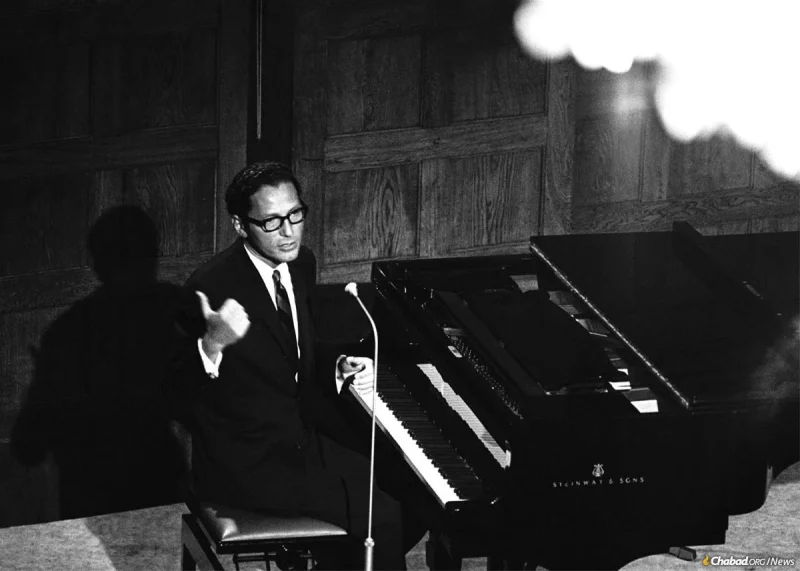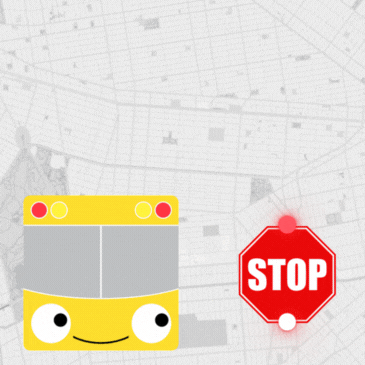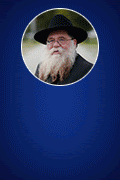
Tom Lehrer Told Me Why He Wrote ‘Hanukkah in Santa Monica’ (Sort Of)
by Dovid Margolin – chabad.org
News of the passing of the great Jewish musical satirist Tom Lehrer reached me after Shabbat in the Catskills, which I had spent within eyeshot of whatever’s left of the old Brown’s Hotel in Loch Sheldrake. I don’t know if Lehrer ever performed at the Brown’s or any of the other Borscht Belt hotels, but I can well imagine an auditorium full of summering American Jews roaring, somewhat uncomfortably perhaps, as Lehrer sang his hit ‘National Brotherhood Week’:
Oh the Protestants hate the Catholics
And the Catholics hate the Protestants
And the Hindus hate the Muslims
And everybody hates the Jews!
Lehrer—a mathematician who in his academic career taught at Harvard, MIT and the University of California, and worked at a point at the Atomic Energy Commission—passed away on Shabbat, July 26 (Rosh Chodesh Av), at the age of 97 at his home in Cambridge, Mass., where he lived when he was not in Santa Cruz, Calif. In its obituary for Lehrer, The New York Times cited a 1981 interview in which he said he would continue living in both places “until my brain turns completely to Jell-O, at which time I will of course move to California full time.”

The most obviously Jewish of Lehrer’s songs was ‘(Spending) Hanukkah in Santa Monica,’ which he wrote in the early 1990s to remedy what he saw as a lack of Chanukah songs. The catchy ragtime number is less savage than most of his better-known hits and expresses the eternal Jewish yearning for the Messianic era as symbolized by sunny blue skies and overall perfect weather (my takeaway at least.)
Lehrer’s passing hit me particularly hard as a writer, for it brought to mind an unfinished article I had in my drafts titled ‘(Spending) Hanukkah in Simcha Monica, Per Capita Menorah Capital of the World.’ The subhead, which I’ve salvaged for this piece, was ‘Lighting a public menorah while wearing a fedora amid the California flora.’ The would-be article was inspired by the fact that though it is rhyming purposes that make Santa Monica the ideal California beach town for Lehrer to spend Chanukah, the place is in fact just that: The per capita menorah capital of the world, courtesy, naturally, of Chabad-Lubavitch of S. Monica.
I wanted to know whether Lehrer was aware of this when he wrote the song. So in 2021 I tracked down his number and called him. And he told me. Sort of.

Real Cool Cat
In 1967 the Rebbe, Rabbi Menachem M. Schneerson, of righteous memory, sent Rabbi Avrohom and Chaya Devorah Levitansky to Los Angeles, Calif., to join Rabbi Shlomo and Miriam Cunin at the nascent Chabad of the West Coast. The Rebbe’s network of Chabad emissaries was not nearly the size that it is today, and California was the frontier, a spiritual desert if there ever was one. California was the place to which Jews from all over America came to escape their community, tradition and roots.
On paper, Rabbi Levitansky, who passed away in 2007 at the age of 63, was an unlikely fit for 1960s L.A. He was a serious Torah scholar, conversant in both its revealed and esoteric parts, and someone who could have easily found a position as the rav of a major Jewish community or perhaps head of a yeshivah. Instead, the Rebbe sent him to L.A., a place marred by drugs, cults and a suffocating vapidness. The young rabbi and his wife, along with the many other emissary couples who’d soon join their ranks, were charged with building an authentic Jewish future in La La Land, a place devoid of both authenticity and Judaism.
These were pioneering days for Chabad’s outreach work. It was in L.A. that Levitansky opened the first-ever Gan Israel day camp (the overnight camp had been founded in upstate New York in 1956), his colorful and energetic persona attracting Jewish families of all backgrounds and giving generations of children a taste of their heritage. True, he was a serious scholar and an uncompromising Chassidic Jew, but he wasn’t afraid to roll up his sleeves. “Rabbi Levitansky is a real cool cat,” generations of Gan Izzy campers sang, “he wears a baseball cap instead of a hat.” By the way, Camp Gan Israel is today the largest Jewish camping network in the world.

In 1973, in response to the Rebbe’s call for the opening of 71 new Chabad institutions over the course of the year (that number corresponding to the Rebbe’s age), the Levitanskys moved to Santa Monica to establish a new Chabad center, presaging any other Orthodox Jewish presence in the city by at least two decades. Levitansky, who spent his first Simchat Torah in town with the one solitary Jew who’d wandered into Chabad’s tiny rented storefront, promptly dubbed the place “Simcha Monica.”
That first Chanukah the rabbi also erected a menorah made out of soda cans in the storefront window. As Chabad’s other programs grew, so did its Chanukah efforts. He began putting a large menorah on the back of a flatbed truck, which he parked in a different part of the city each night of Chanukah, gathering crowds before making a public lighting ceremony. Before you knew it, Chabad was erecting menorahs at the Third Street Promenade, City Hall, Santa Monica Airport and dozens of other sites.
“My father took every campaign of the Rebbe’s very seriously,” Levitansky’s eldest son and successor as director of Chabad of S. Monica Rabbi Isaac Levitansky told me. “Central to Chanukah is the idea of always increasing in matters of holiness, so every year we tried adding at least one new menorah. Over time it snowballed.”
By the time Rabbi Levitansky passed away, Chabad of S. Monica was putting up 30 menorahs throughout the city, ranging in height from 6 to 15 feet. When I started my article in 2021 they were putting up 75 menorahs, and when I returned to it last year it was up to 80. Taken together, these menorahs are seen each year by hundreds of thousands of people each night of the eight-day holiday, reminding young and old of the miracle of the lights and the victory of good over evil.

Stories of the menorahs’ impact abound: The woman who hid that she was Jewish from her family and would walk down the block each night to see one of the menorahs and know what night of Chanukah it was; the Jewish family visiting from abroad who had totally forgotten it was Chanukah until they were reminded by the ubiquitous lights (and promptly received a tin menorah from some nearby Chabad volunteers); the senior citizen drawn by the menorah who ended up putting tefillin on for the first time in his life, celebrating his bar mitzvah at the age of 82.
In other words, Lehrer was absolutely right when he sang, “In December there’s just one place for me,
Amid the California flora
I’ll be lighting my menorah
Like a baby in his cradle
I’ll be playing with my dreidel
Here’s to Judas Maccabeus
Boy, if he could only see us
Spending Hanukkah
In Santa Monica
By the sea”
So, was Lehrer inspired by Chabad of Santa Monica’s menorah displays?

‘Well, isn’t that something?’
The era of phone books being helpful—or even existing—is coming to an end, but I guess Lehrer was old enough not only to have a home phone, but to pick it up when it rang.
“Yes,” Lehrer told me when I asked him what inspired the song, “I saw those glittering Chabad menorahs spread throughout Santa Monica, and I thought to myself ‘Well, isn’t that something?’ There was something so magical about that scene, about the Chabad menorah being lit by a rabbi in a black fedora amid the California flora, that I sat down and wrote this song. I hope it has inspired my brethren to remember to kindle the lights of the menorah on each of the eight nights of Chanukah wherever they might be. Thank you so much for asking.”
That, at least, is how I heard it, and in fact, Mr. Lehrer gave me full permission to quote him as such. For the sake of journalistic integrity, however, I will provide his exact words.
“Whatever you want to do, do it, you have my permission to do it—is that what you’re looking for?,” he yelled. When I repeated that I just wanted to know whether it was truly a coincidence that ‘(Spending) Hanukkah in Santa Monica’ was about a place where Chanukah was indeed so front and center, he shot back at me: “ No no, I don’t do that, just say whatever you want and attribute it to me. I’ve relinquished all interest in my songs, so you do whatever you want. Ok? Good bye.”
So there you have it, from the mouth of Mr. Tom Lehrer himself.

The Two Jesters
The Baal Shem Tov, founder of the Chassidic movement, taught that there are no coincidences—everything is hashgacha pratit, Divine providence. “Not only are all the particular activities of the created beings [controlled by] Divine providence,” the Rebbe explained, “[but] every particular movement of an individual created being has a connection to the intent of the creation as a whole … . A slight movement of one blade of grass fulfills G‑d’s intent for the creation as a whole.”
Surely there is no coincidence that one of the most famous popular Chanukah songs extols spending the Festival of Lights in Santa Monica, a place where a giant menorah might have once raised eyebrows but is today home to the highest number of them in the world. Neither it is a coincidence that the very funny Lehrer passed away on Rosh Chodesh Av, which marks the beginning of the Nine Day mourning period leading up to Tisha B’Av, 9th of Av, a fast day when the Jewish people commemorate the destruction of the Holy Temples in Jerusalem and many other tragedies in our long and sometimes difficult history.
Laughter forces us to not wallow in the details of the moment, allowing us to step back and see the picture for what it is. One can either be depressed by much of the world’s reaction since the horrors of Oct. 7, shocked not only by the heartlessness displayed towards Jewish suffering but the ensuing transformation of Jews into villains, or view the previous decades of lip-service and exaltation of “tolerance” as an extension of the very same “National Brotherhood Week” skewered by Mr. Lehrer. Instead of worrying about what people think of the Jews, we can focus our energies on living and acting like Jews.
“The Talmud (Taanit 22a) relates that there were ‘two jesters’ who ‘were joyous and would bring joy to others,’ and therefore ‘they are meritorious of the World to Come,’” the Rebbe noted in 1980. “The Talmud doesn’t tell us that they merited the World to Come because of their scholarship and the like; rather, it was simply because ‘they were joyous and brought joy to others.’”














G.Singh
Great story!